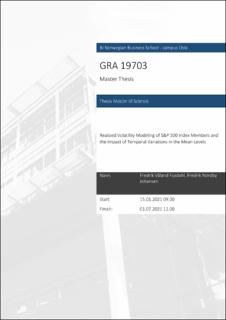Realized Volatility Modeling of S&P 500 Index Members and the Impact of Temporal Variations in the Mean Levels
Master thesis
Permanent lenke
https://hdl.handle.net/11250/2827151Utgivelsesdato
2021Metadata
Vis full innførselSamlinger
- Master of Science [1621]
Sammendrag
Using a daily panel dataset including almost all the stocks in the S&P 500 dating
back to 1985, we document strong similarities in the risk dynamics across stocks.
The similarities in risk dynamics are exploited by implementing volatility forecasting
models estimated using panel-based methods that aggregate information
across stocks and force the coefficients to be the same for each stock. The models
that exploit these commonalities in risk characteristics across assets produce
highly competitive out-of-sample risk forecasts compared to more conventional
individual asset-specific models that implicitly ignore the similarities in risk dynamics.
We estimate the models on the daily range of the highest and lowest
log intraday stock price, which has been shown to be a good alternative to the
high-frequency-based realized volatility (RV) estimator of the integrated volatility.
Further, we normalize the RV by the time-varying mean of the RV retrieved
from the Kalman Filter and -Smoother as an intermediate step before model
estimation. Normalizing the RV before using panel-based estimation methods
produces very promising out-of-sample risk forecasts compared to the widely
accepted Heterogeneous Autoregressive (HAR) model. Further, it improves the
out-of-sample predictive power of the unnormalized models. An important feature
of the panel-based models we present is the inclusion of a time-varying
mean of each stock. Including this feature mimics introducing an asset-specific
intercept for each stock and captures the differences in risk dynamics across assets,
as well as the temporal variations in the mean levels.
Beskrivelse
Masteroppgave(MSc) in Master of Science in Quantative Finance - Handelshøyskolen BI,2021
